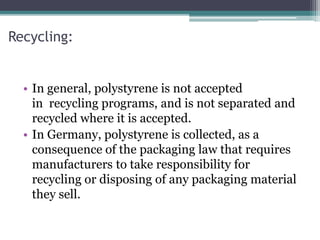Polystyrene
- 2. Description: • Polystyrene is a synthetic polymer made from the monomer styrene, a liquid petrochemical. • Polystyrene can be rigid or foamed. • General polystyrene is clear, hard and brittle. • It is a very inexpensive resin per unit weight. • It is a rather poor barrier to oxygen and water vapor.
- 3. Origin and history: • Polystyrene was discovered in 1839 by Eduard Simon, in Berlin. • From the resin of a tree, he distilled an oily substance, a monomer that he named styrol. • Days later, Simon found that the styrol had thickened, presumably from oxidation, into a jelly he dubbed styrol oxide. • They called their substance metastyrol. • But later the substance receiving its present name, polystyrene.
- 4. Properties: PS Polystyrene • Thermal properties: The "compact" polystyrene presents the lowest thermal conductivity of all thermoplastics. • Optical properties: While the PS shock is fully opaque, the PS Crystal is transparent. • Electrical properties: Polystyrene has very low electrical conductivity, in other words, it is an insulator.
- 5. Aplicattions: Polystyrene shock Crystal polystyrene Expanded form Extruded shape
- 6. Recycling: • In general, polystyrene is not accepted in recycling programs, and is not separated and recycled where it is accepted. • In Germany, polystyrene is collected, as a consequence of the packaging law that requires manufacturers to take responsibility for recycling or disposing of any packaging material they sell.
- 7. Ampliation: • Polystyrene foam is a major environmental problem. Used in the packaging of products and transportation industry, occurs in the world tons of it each year. The fact that it is not recyclable increases the ecological impact. Contamination by polystyrene foam in landfills.







